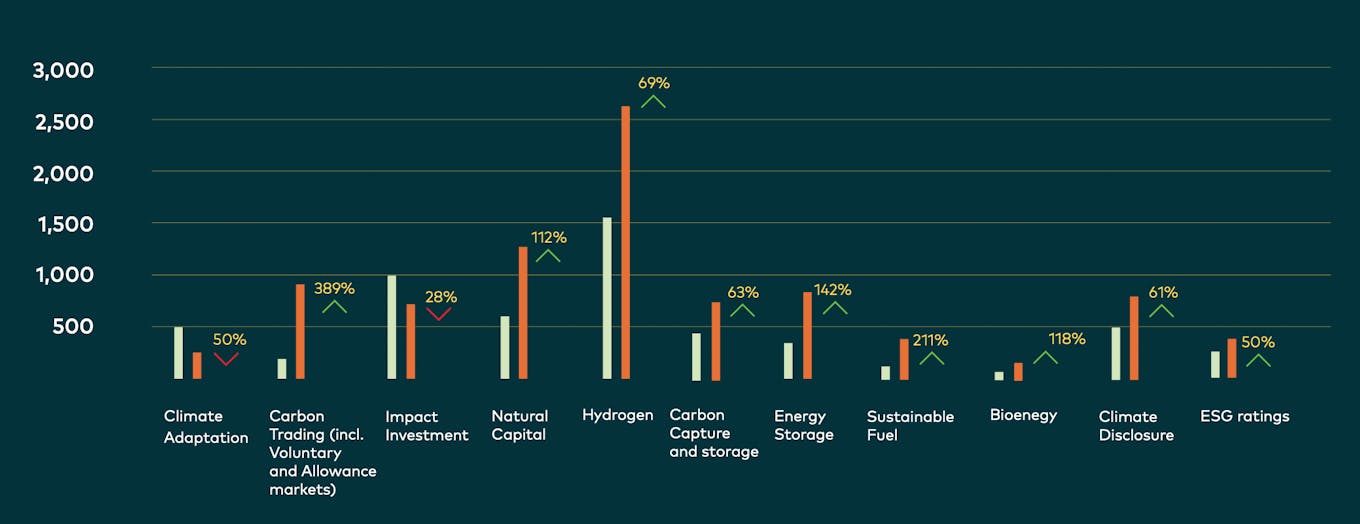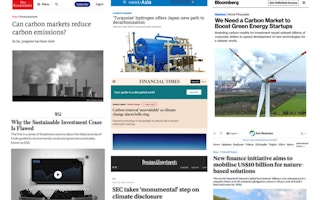Media interest in environmental, social and governance (ESG) issues has surged over the past year, and the editorial focus has started to shift from problems to solutions — carbon markets being the new favourite among editors — according to a study of mainstream and trade English-language publications.
To continue reading, subscribe to Eco‑Business.
There's something for everyone. We offer a range of subscription plans.
- Access our stories and receive our Insights Weekly newsletter with the free EB Member plan.
- Unlock unlimited access to our content and archive with EB Circle.
- Publish your content with EB Premium.
Mentions of ESG in newspapers articles increased by 54 per cent between 2020 and 2021, the study, titled The communications of climate transition, found. “The increased urgency around climate action coupled with the viability of [climate] solutions has translated into an awareness of these on people’s minds, which we see play out in more media attention,” said Charlie Morrow, director, Cognito, the public relations firm behind the research.
The research screened 25,000 articles from a mix of news sources. These include Western international news outlets such as Bloomberg, The Economist, Financial Times, Reuters and Wall Street Journal, Asian titles Nikkei and South China Morning Post, and specialist publications Asian Investor, Eco-Business, Pensions & Investments and Responsible Investor.
Researchers also quizzed journalists on how they saw the media’s coverage of sustainability issues changing. “We are not yet at peak climate coverage,” the report concluded.
In 2021, climate-related problems such as intensifying natural disasters, environmental degradation and climate migration appeared roughly three times more in press articles than potential fixes. But environmental solutions were covered 50 per cent more in 2021 than in 2020.
Bloomberg’s solutions reporting more than doubled (228 per cent) in 2021; South China Morning Post’s tripled (330 per cent).
The minutiae of ESG is now being covered by the mainstream press. In January, even the news quiz on BBC R4 was making jokes about the taxonomy. This is how broad it is going.
Chris Hall, founding editor, ESG Investor
Hydrogen was by far the most written about solution. Japanese business publication Nikkei ramped up its hydrogen coverage more than any other title in 2021, as Japan explored new ways to decarbonise and harness a market predicted to be worth US$10 trillion by 2050.
Climate adaptation and impact investing are the only sustainability topics that have fallen out of favour among newspaper editors. Asian Investor’s coverage of impact investing almost halved in 2021, making way for stories about carbon trading.
Carbon trading was the most fashionable new topic, with media mentions quadrupling as journalists dug into a new industry attracting a lot of money and controversy. The value of global carbon markets broke grew by 2.5 times in 2021, as corporations raced to fulfill net-zero pledges.

Mentions of climate transition solutions in major English language media outlets 2020 versus 2021 [click to enlarge]. Source: The communications of climate transition
The climate conservation is spreading out, not just getting louder
Media coverage of sustainability issues is becoming more varied, with a broader range of ESG-related issues covered by the press — particularly the business press, which has been investigating how different industries are responding to the climate transition.
ESG themes to watch in the media
The following insights came from interviews with journalists covering ESG topics; what is the media going to cover more of in the future?
1. How the carbon markets develop, particularly voluntary carbon markets as pressure builds for standardisation, integrity and quality reporting.
2. The origin of capital – the relationship between private equity, public equity and debt markets in financing the transition.
3. Responsible asset ownership – the tension between divestment and engagement and what real engagement looks like.
4. Specialist providers of climate solutions and the impact of consolidation in the investment management sector.
5. More focus on specific solutions such as nature-based, biodiversity and natural capital.
6. ESG data and ratings will more heavily scrutinised. What’s the best way of assessing real ESG credentials and profiles of businesses?
In 2020, The Wall Street Journal’s coverage of climate solutions was dominated by impact investment. In 2021, its stories focused on a broader range of topics, including climate disclosure, carbon trading, energy storage and negative carbon. Reuters and Bloomberg also diversified their coverage in 2021. “The overall conversation [about the climate transition] is spreading out, not just getting louder,” the report noted.
ESG coverage is now a “constant” for media companies, the report found. Media businesses have devoted more resources to climate issues over the past year. Publications including Bloomberg, Business Insider and Singapore’s Business Times, have created specialist ESG reporting teams.
“This is the year we all become climate reporters,” commented Andrew Freedman, energy and climate reporter for Axios, a US-based news and politics publication.
What journalists want
Interviews with journalists revealed that most want to be able to go into greater depth in their coverage, using data to scrutinise the progress governments and businesses are making in their climate goals. But reporters are “in an ongoing fight against banality” from corporate statements around sustainability, the report noted.
“The pull towards the trite and hackneyed is practically omnipresent in corporate statements. Take this sentence: ‘we are completely committed to becoming a fully green and sustainable organisation.’ Variations of it have been peppered into speeches at international conventions, introductions to annual reports and calls with investors. But it means nothing,” the report said.
The media is now focusing more on the steps companies are making to fulfill sustainability commitments, the report found. Chris Hall, founding editor of sustainable investment journal, ESG Investor, said: “Stories that evidence change are essential. These can range from innovative financial instruments, to new projects in renewables and across other sectors that decrease reliance on fossil fuels.”

















